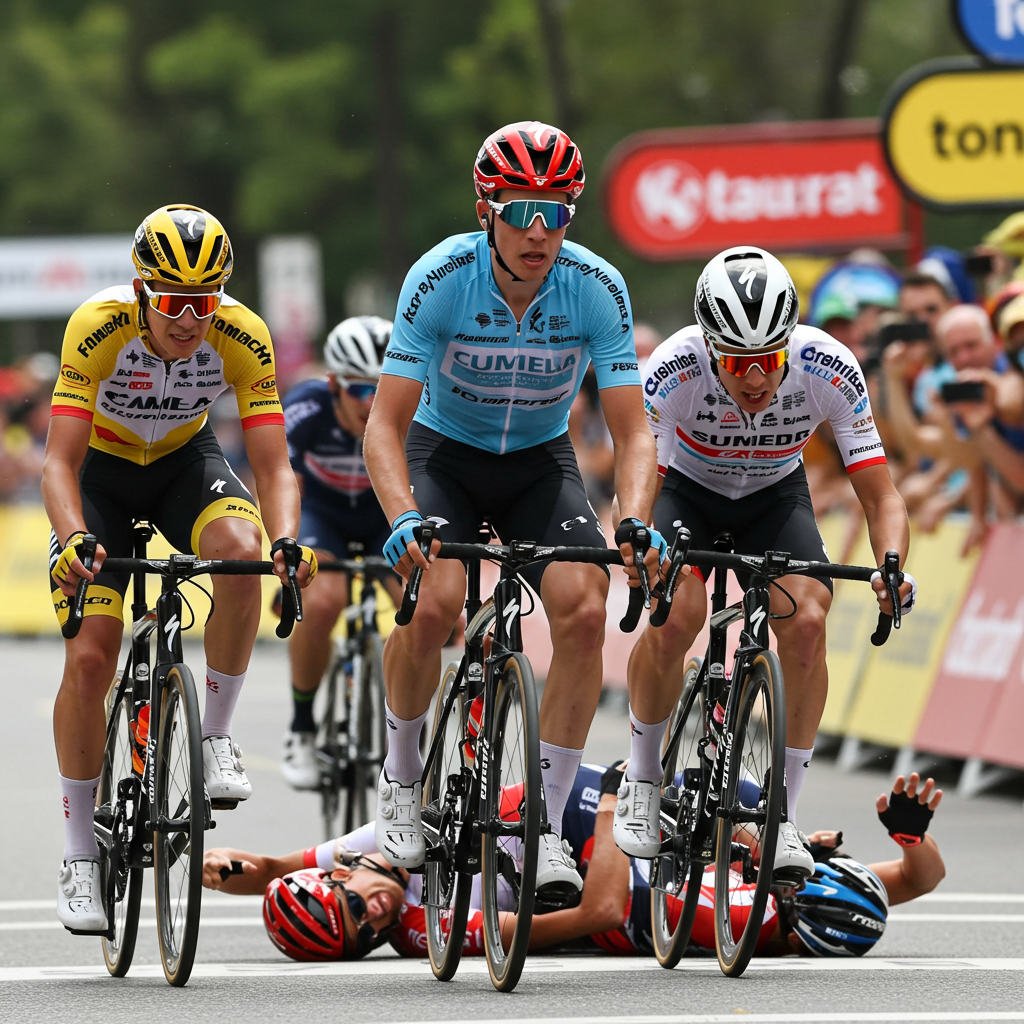stage three of the Tour de France 2025, stretching from Valenciennes to Dunkirk, was anticipated by many to be a calmer transition day after a demanding opening weekend. For over 100 kilometers, the peloton seemed content to cruise through northern France, averaging a leisurely pace. riders conserved energy, knowing the flat profile and likely headwind into Dunkirk made a breakaway improbable. However, this deceptive tranquility shattered dramatically in the final third of the stage, transforming a seemingly straightforward sprint opportunity into a scene of widespread chaos and significant consequences for several key riders and teams.
From Calm Cruise to Catastrophe
The early hours of the 178.3-kilometer stage unfolded exactly as expected. There were no significant attacks, no breakaway formed, and the main bunch rolled along cohesively. This slow pace (reportedly averaging just 36 kph in the first hour) reflected the consensus that this was a day reserved for the sprinters, whose teams were motivated to keep the race together. Alpecin-Deceuninck, aiming for a third consecutive stage win after their dominance on days one and two, notably controlled the front of the pack, maintaining a long, steady line of riders.
This state of affairs shifted abruptly with approximately 60 kilometers remaining. As the race neared the intermediate sprint point in Isbergues, positioning intensified, leading to a major pile-up that sent shockwaves through the peloton.
Green Jersey Holder Abandons Tour de France
The most impactful incident occurred during the build-up to the intermediate sprint. As riders jostled for points, a collision involving Bryan Coquard and Laurenz Rex resulted in Coquard being shunted into the path of Jasper Philipsen. Philipsen, the winner of Stage 1 and currently wearing the prestigious green points classification jersey, was violently thrown over his handlebars.
The crash looked immediately serious, with Philipsen clutching his shoulder in obvious pain. His jersey was shredded, and it quickly became clear that the Belgian rider, who had also worn the yellow jersey earlier in the race, would be unable to continue. Later confirmation revealed the severity: a displaced fracture of the right collarbone requiring surgery and at least one broken rib.
Philipsen’s abandonment marks a major blow for Alpecin-Deceuninck, ending their dream start and forcing a complete reassessment of their race strategy. It also signifies the earliest exit for a jersey wearer in the Tour de France since 2017. Coquard, though completing the stage, later apologized for the unintentional contact and received a yellow card and points deduction from the race jury.
Turmoil in the Closing Kilometers
Despite the initial major crash, the peloton regrouped, and the focus shifted towards the expected sprint finish in Dunkirk. Race organizers had established an extended 5-kilometer safety zone before the finish line, intended to mitigate risks. However, even within this protected area, the inherent dangers of high-speed bunch finishes on narrow roads became brutally apparent.
With around 3.1 kilometers left, the road narrowed significantly. Riders attempting to gain a forward position on the right-hand side triggered a crash that brought down several prominent names, including race favorite Remco Evenepoel (Soudal Quick-Step), Jordi Meeus (Red Bull-Bora-Hansgrohe), and former Tour winner Geraint Thomas (Ineos Grenadiers). While Roglič somehow avoided the pile-up, the incident split the peloton.
The chaos escalated further in the final few hundred meters. A tight, potentially controversial chicane just 350 meters from the line forced riders to navigate a sharp bend at high speed. This corner became the site of another multi-rider collision. Team TotalEnergies rider Emilien Jeanniere suffered a particularly nasty fall, being catapulted into the roadside barriers. Remarkably, Jeanniere managed to get back on his bike and cross the finish line nearly nine minutes after the winner, a testament to his resilience.
A Photo Finish Amidst the Mayhem
Amidst the multiple crashes and split peloton, a select group of sprinters contested the stage victory. Quickstep’s European champion, Tim Merlier, and Lidl-Trek’s powerful Italian, Jonathan Milan, surged towards the line in a head-to-head battle.
Milan, riding a strong final kilometer despite his lead-out train dissipating, launched his sprint early. Merlier managed to find a crucial slipstream late, drawing alongside the Italian. The two riders were neck-and-neck in the final meters, throwing their bikes forward in a desperate lunge. It was so close that Merlier hesitated to celebrate, unsure if he had won, sheepishly pulling his arm back down after initially raising it.
Only a photo finish could separate them, confirming that Tim Merlier had edged out Jonathan Milan by a matter of millimeters. This victory marked Merlier’s second career Tour de France stage win, his first coming four years prior. Milan, while disappointed to miss the win, took a significant consolation prize: he moved into the lead of the points classification, inheriting the green jersey from the injured Philipsen. Milan now leads the competition with 81 points, four ahead of Biniam Girmay. Both riders will likely eye Stage 8 as the next clear opportunity for a pure sprint showdown.
Scrutiny Over Finish Design and Safety
Stage three’s tumultuous conclusion has reignited debate within the cycling world regarding race route design and rider safety. Several team personnel openly criticized the finish in Dunkirk, particularly the sharp bend just 350 meters out.
Critics argue that this chicane forced sprinters, traveling at high speeds, to deviate from the most direct line and potentially move laterally across designated sprint lanes – a practice generally considered unsafe and potentially in contravention of UCI regulations. Red Bull-Bora-Hansgrohe’s head of engineering, Dan Bigham, had previously expressed concerns that the UCI focused on minor safety rules while potentially overlooking more significant structural issues in route design.
Intermarché-Wanty’s directeur sportif, Aike Visbeek, whose team had two riders crash on the day, did not mince words when asked if the finish was safe. “No,” he replied directly. Visbeek suggested that on stages designated for sprinters after an otherwise easy day, riders become more aggressive, making dangerous finishes even more perilous. He squarely placed the responsibility for such designs with the UCI.
Impact on the Race and Looking Ahead
The events of Stage 3 have significantly shaped the early narrative of the Tour de France. Alpecin-Deceuninck, after a dream start, faces the challenge of losing its key sprinter and points classification leader. The multiple crashes involving GC contenders like Evenepoel and Thomas, while seemingly not resulting in major immediate consequences for their overall bids, highlight the constant peril faced by favorites simply trying to navigate the peloton.
Meanwhile, Jonathan Milan’s ascension to the green jersey provides a new storyline in the points competition. The stage also showcased Merlier’s sprinting prowess, proving he is a formidable opponent for the fastest men in the bunch.
Stage 4 presents a different challenge: a hilly 173-kilometer route from Amiens to Rouen. While potentially another opportunity for sprinters capable of handling climbs, the profile with several categorized climbs in the final 50km could favor a reduced bunch or even a late attack, keeping the tension high and GC contenders alert, especially with a flat time trial looming on Stage 5.
Frequently Asked Questions
What was the main impact of the crashes on Tour de France Stage 3?
The crashes on Stage 3 had major consequences, most notably forcing the abandonment of green jersey wearer Jasper Philipsen due to a fractured collarbone and broken rib. Other incidents in the final kilometers brought down key riders like Remco Evenepoel and Geraint Thomas, highlighting safety concerns despite a relatively slow pace for much of the day.
Why were cyclists concerned about the safety of the Stage 3 finish in Dunkirk?
Concerns centered on a sharp chicane located just 350 meters from the finish line. Team personnel argued that this tight bend forced riders to change lines dramatically at high speed, potentially moving across designated sprint lanes and creating a highly dangerous situation, which some suggested went against typical safety protocols and UCI regulations.
Who won Tour de France Stage 3 and what happened in the sprint finish?
Tim Merlier of Soudal Quick-Step won Stage 3 in a dramatic photo finish against Jonathan Milan. Despite a chaotic final kilometer marked by crashes, Merlier found a late slipstream to pull level with Milan in the final meters. The win was so close that Merlier was initially unsure if he had taken the victory before confirmation came from the photo finish camera.
Stage three of the Tour de France 2025 will be remembered not for its initial calm, but for the sudden and severe chaos that unfolded in its final hours. Tim Merlier’s hard-fought victory in a photo finish over Jonathan Milan was overshadowed by multiple crashes that took out the green jersey wearer Jasper Philipsen and rattled several General Classification contenders. The events served as a stark reminder of the inherent dangers of professional cycling, particularly in congested, high-speed finishes, raising important questions about route design and rider safety moving forward in the race.


